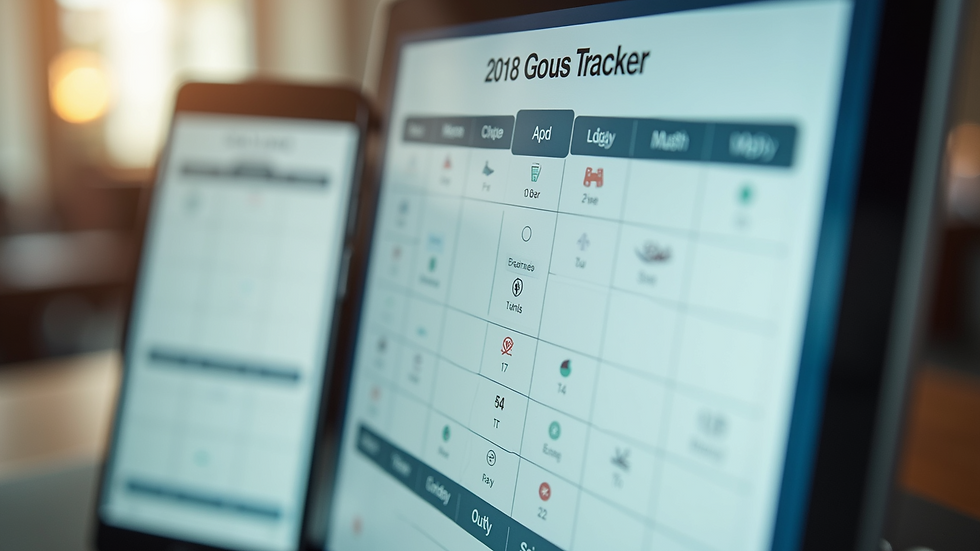Top Tips for Staying Consistent with Your Fitness Routine
- Dan Minnicks

- May 29
- 5 min read
Staying consistent with your fitness routine can often feel like a daunting task. Between busy schedules, fluctuating motivation, and sometimes limited access to resources, it's easy to lose sight of your fitness goals. However, by implementing some straightforward strategies, you can cultivate a sustainable routine that fits into your life seamlessly.
Understanding Your Fitness Routine
Creating a solid foundation for your fitness routine starts with understanding what works best for you. The first step is to identify your specific fitness goals. Are you looking to lose weight, build muscle, enhance your endurance, or just maintain overall health? Having a clear goal helps you stay focused and provides direction for your workouts.
For example, if you want to lose weight, this could entail incorporating more cardiovascular exercises like running or cycling into your routine. In contrast, those looking to gain muscle might focus on strength training exercises such as lifting weights. Knowing your goal allows you to tailor your fitness plan more effectively, increasing your likelihood of consistency.

Finding the Right Routine for You
Once you've established your goals, the next step is to find the fitness routine that suits your lifestyle. Consider these practical tips:
Assess Your Schedule: Identify blocks of time during your week when you're most available for workouts. This will help you determine how often you can realistically exercise.
Choose Activities You Enjoy: You're more likely to stick to a routine if you enjoy the activities. Experiment with various workouts like dancing, swimming, or hiking.
Create a Balanced Plan: Incorporate a mix of aerobic, strength, flexibility, and balance exercises. The CDC recommends at least 150 minutes of moderate aerobic activity each week, alongside two days of muscle-strengthening activities.
By establishing a routine that matches both your goals and your preferences, you're setting yourself up for long-term success.

Setting Realistic Goals
Setting realistic and achievable goals is key to maintaining motivation. Deciding to run a marathon next month after being inactive for years might set you up for disappointment. Instead, consider the SMART criteria:
Specific: Clearly define what you want to achieve.
Measurable: Track your progress with numbers (e.g., how many workouts per week).
Achievable: Make sure your goals are challenging yet attainable.
Relevant: Ensure they align with your overall fitness aspirations.
Time-bound: Set deadlines for your goals to create urgency.
For instance, aiming to work out three times per week for 30 minutes for the next month is a SMART goal. Once you've achieved this, you can then increase the frequency or duration, gradually building your routine over time.

Building a Support System
Having a support system is important for maintaining consistency in your fitness routine. This could include friends, family, or fitness communities. Here’s how you can create one:
Workout Buddy: Find a friend who shares similar fitness goals. Exercising together not only makes it more enjoyable but also holds you accountable.
Join a Class or Group: Consider enrolling in a local fitness class or joining an online fitness community. Being part of a group fosters accountability and often provides motivation.
Share Your Goals: Don’t hesitate to tell people about your fitness goals. Verbalizing your intent often reinforces your commitment to actualize them.
Moreover, tools like our Free Self-Assessment and free Overcome Plateaus guide can provide comprehensive resources for fitness enthusiasts. Accessing expert advice and peer support can be invaluable as you navigate your journey.
Tracking Your Progress
Monitoring your progress is essential for staying consistent. Seeing how far you’ve come can be incredibly motivating. Here are several methods to keep track:
Fitness App: Use a fitness app to log your workouts and track progress over time. Many apps provide features like social sharing, fostering community support.
Workout Journal: Keep a journal where you can jot down exercises performed, duration, and personal reflections on each workout.
Progress Photos: Take periodic photos to visualize your transformation. This provides a tangible reminder of your efforts.
By tracking your progress, you create a reference point that can serve as motivation during tough times.
Overcoming Barriers to Consistency
Everyone faces obstacles on their fitness journey. Here are some common barriers and how to overcome them:
Time Constraints: Busy schedules can make it difficult to fit in workouts. Consider shorter, more intense workout sessions, such as HIIT (High-Intensity Interval Training) that can be completed in 20-30 minutes.
Lack of Motivation: To rekindle motivation, revisit your "why." Focus on the benefits of regular exercise and why you started your fitness journey.
Plateaus: It’s common to hit a plateau after achieving initial results. To avoid stagnation, periodically change up your routine by trying new exercises or increasing weights.
By proactively identifying potential barriers to consistency, you can prepare strategies in advance to overcome them.
Celebrate Small Wins
Consistency is about the journey, not just the destination. Celebrating small victories can significantly enhance your motivation. Here are suggestions for rewarding yourself:
Treat Yourself: After reaching a mini-goal, treat yourself to something you've been wanting—anything from new workout gear to a relaxing massage.
Acknowledge Progress: Note improvements in strength, endurance, or overall fitness regularly. Take pride in your hard work and dedication.
Reflect on Changes: Write about how your routine affects your life positively, from improved energy levels to better mood and confidence.
Recognizing incremental progress cultivates a positive mindset, making you more likely to stick to your fitness regimen.
Stay Flexible
While consistency is vital, flexibility is equally important. Life can throw unexpected challenges your way, from travel to sudden changes in schedule. Instead of being rigid in your routine, adapt as needed:
Home Workouts: On days when you can’t make it to the gym, have a set of home workouts you can rely on.
Switch It Up: If you’re feeling burned out or unmotivated, try something new. This could be a new type of workout, such as yoga, martial arts, or pilates.
Flexibility allows you to maintain your practice without feeling overwhelmed or defeated when things don’t go as planned.
Embrace the Journey
The path to fitness is personal and often takes time. Embrace the process and remember that it's perfectly normal to face ups and downs. Staying consistent with your fitness routine is about creating lifelong habits and finding joy in the activity.
Remember, the most significant changes often happen slowly, and every step forward is a victory. Make peace with the concept of progress over perfection, and focus on developing a routine that feels right for you.
By implementing some of these tips and actively working towards staying consistent, you'll find that maintaining your fitness routine is not only achievable but also incredibly rewarding.

Your fitness journey awaits, and by knowing yourself, building a support system, and celebrating small victories, you can find the success and consistency you seek.




Commentaires